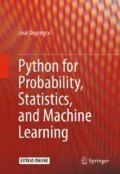Abstract
Probability is tricky to understand and trickier to apply. Through a detailed series of examples that we work using multiple methods using Python modules, we illustrate how to use geometrical projections to develop intuition regarding conditional probability and how to apply them to difficult problems. We also discuss the concept of information entropy, which will become important for certain machine learning methods.
Change history
20 December 2019
The original publication can be found online at https://doi.org/10.1007/978-3-319-30717-6_5
Notes
- 1.
See appendix for proof using the Cauchy-Schwarz inequality.
- 2.
- 3.
Cumulative density function. Namely, \(F(x)=\mathbb {P}(X < x)\).
- 4.
Note that this example density does not exactly integrate out to one like a probability density function should, but the normalization constant for this is distracting for our purposes here.
References
F. Jones, Lebesgue Integration on Euclidean Space, Jones and Bartlett Books in Mathematics (Jones and Bartlett, London, 2001)
G. Strang, Linear Algebra and Its Applications (Elsevier Science, 2014). https://books.google.com/books?id=9A7jBQAAQBAJ, ISBN 9781483265117
E. Nelson, Radically Elementary Probability Theory, Annals of Mathematics Studies (Princeton University Press, Princeton, 1987)
T. Mikosch, Elementary Stochastic Calculus with Finance in View, Advanced Series on Statistical Science & Applied Probability (World Scientific, Singapore, 1998)
H. Kobayashi, B.L. Mark, W. Turin, Probability, Random Processes, And Statistical Analysis: Applications To Communications, Signal Processing, Queueing Theory And Mathematical Finance, Engineering Pro Collection (Cambridge University Press, Cambridge, 2011)
Z. Brzezniak, T. Zastawniak, Basic Stochastic Processes: A Course Through Exercises, Springer Undergraduate Mathematics Series (Springer, London, 1999)
D.J.C. MacKay, Information Theory, Inference and Learning Algorithms (Cambridge University Press, Cambridge, 2003)
T. Hastie, R. Tibshirani, J. Friedman, The Elements of Statistical Learning: Data Mining, Inference, and Prediction, Springer Series in Statistics (Springer, New York, 2013)
W.L. Dunn, J.K. Shultis, Exploring Monte Carlo Methods (Elsevier Science, Boston, 2011)
N.L. Johnson, S. Kotz, N. Balakrishnan, Continuous Univariate Distributions, vol. 2, Wiley Series in Probability and Mathematical Statistics: Applied Probability and Statistics (Wiley & Sons, New York, 1995)
Author information
Authors and Affiliations
Corresponding author
Rights and permissions
Copyright information
© 2016 Springer International Publishing Switzerland
About this chapter
Cite this chapter
Unpingco, J. (2016). Probability. In: Python for Probability, Statistics, and Machine Learning. Springer, Cham. https://doi.org/10.1007/978-3-319-30717-6_2
Download citation
DOI: https://doi.org/10.1007/978-3-319-30717-6_2
Published:
Publisher Name: Springer, Cham
Print ISBN: 978-3-319-30715-2
Online ISBN: 978-3-319-30717-6
eBook Packages: EngineeringEngineering (R0)

